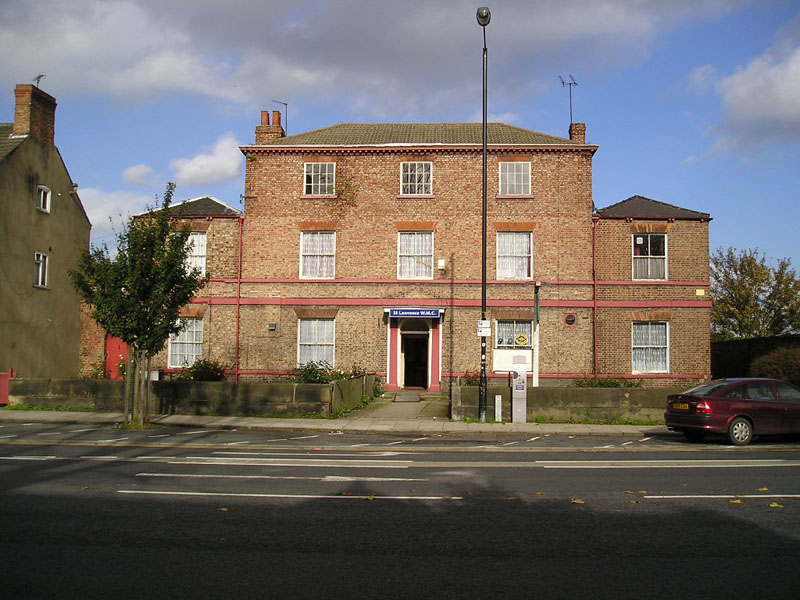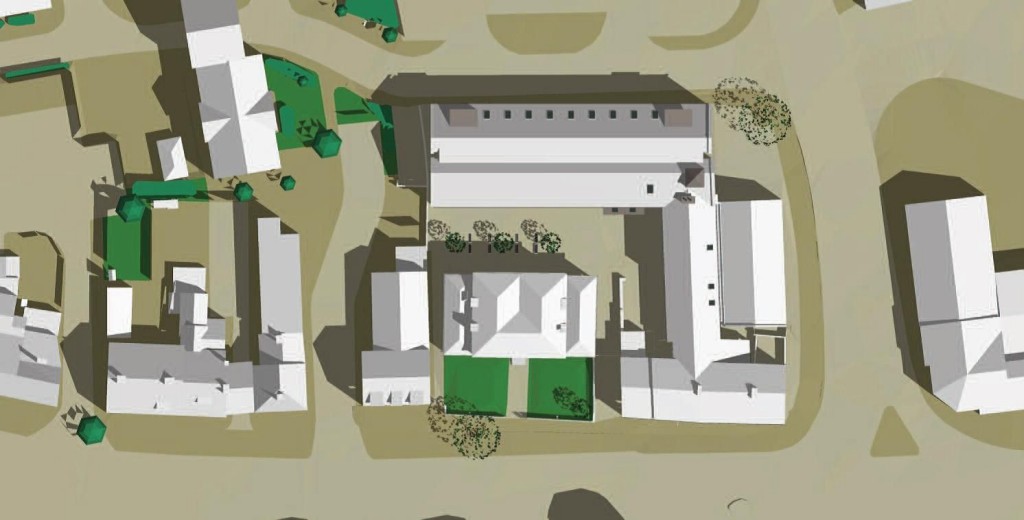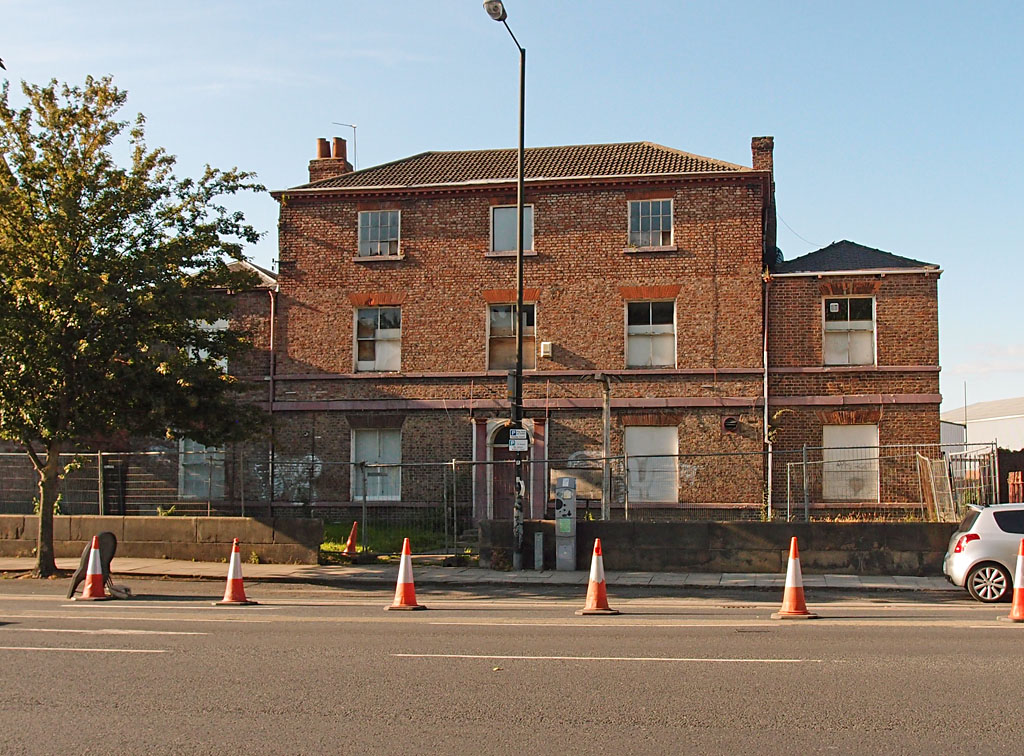Many readers will be familiar with this building, the St Lawrence WMC and former Tuke family home. On these pages we’ve occasionally revisited to see if anything had changed. It has been empty for years, so long that it was seen as an ‘at risk’ building.
A planning application for its remodeling as student accommodation — with new additions on the land at the back and to the side of it — is to be decided at a meeting of the council’s planning committee tomorrow (Thursday).
The meeting agenda and other information can be found on this link.
I imagine the meeting will be available to view live from 4.30pm via www.york.gov.uk/webcasts and also later on the city council’s YouTube channel.
The planning application documents (15/02440/FULM) (and the associated application re the listed building consent: 15/02441/LBC) are worth a look.
The Committee Report summarises comments and objections received and the relevant planning law and guidelines. PDF on this link.
This is another application by S Harrison developments, who at present also have an application in for the conversion of the Groves Chapel.
Here’s an image of the proposed development at the St Lawrence WMC, taken from their website:
Studentification …
A big subject, and one I’ve wanted to write about many times. Perhaps now though isn’t the time to go into depth and debate. Though ‘studentification’ clearly is an issue in the city in recent years it’s a shame that debate has flared up over this particular proposed development.
The Press has reported on the plans a couple of times recently, focusing on this issue of ‘studentification’, picking up on a thoughtful and considered letter from Rev Jane Nattrass, on behalf of the Parochial Church Council of St Lawrence (PDF).
The way this was reported in the Press might have suggested that the letter was some kind of passionate and spontaneous protest. It wasn’t — it was a response to a planning application. Neighbours are always invited to comment. The church, opposite, will have been invited to respond to the proposals.
Jane Nattrass included in her letter a link to an interesting and informative document on the effects of ‘studentification’ — PDF on this link. Many readers will recognise many of its points as relevant to their own residential areas. More on that story later perhaps.
One recent objection from a resident describes her experiences and concerns regarding the student housing in the area. It’s heartfelt in its description of the changes in an area when many homes are occupied by young people who are essentially passing through, in a particular phase of their lives. It’s here on this link (PDF) (but won’t be once the application has been decided as comments are usually removed).
The increase in the student population in recent years meant that much more of the city’s housing stock was bought up and let out to students. This, understandably, caused concern and upset. So then there were attempts to deal with this, and purpose-built student blocks were built instead. This hasn’t been popular either.
Several massive student blocks have appeared on this side of town. Much larger developments than this one.
This building has been neglected for a decade. It might be good to see it back in use with people living under its roof?
Not too big, and adaptable?
The available plans and drawings suggest that the new build at the back will be of a modest height and won’t overshadow the house itself.
This old listed house has been looking increasingly decrepit over the time I’ve had this website, and no one has shown much interest in preserving and reusing it, until this planning application went in.
One thing I’ve wondered, regarding all this student accommodation, is what would happen to it if the city stopped attracting so many students. This is mentioned in the committee report as something considered: the converted building could be used for general ‘non-student’ rent.
the rooms include both bathrooms and kitchens and are therefore selfcontained and capable in the longer-term of being used as general flatted accommodation by the general public.
(source: Committee Report (PDF))
So that’s good, isn’t it.
And the pub …
The loss of the Tam o’Shanter pub seems to me the main issue in this proposed development. It doesn’t seem to have got much attention, which seems unusual, for a pub. There’s been one article in the Press.
I’ve never been in the pub, so have had to rely on what other people have told me and comments online. It sounds like more of a ‘locals’ pub than a student pub. There are of course other pubs not far away, so perhaps no one minds that much. If you do, please add a comment.
I imagine this development will be approved, as all things considered there seems to be no reason not to approve it.
If you’re at all interested in how the planning process works I’d recommend watching the webcast of the meeting, when these issues will be discussed.








I popped into the Tam, for the very first time, last January. I’d always wanted to call in but, like many I’ve spoken to, I’d been put off by an ill gotten reputation. As I’d walked back from the Borthwick, had a couple of hours to kill and was a little thirsty, I grasped the nettle and went in, and I was so glad that I did. The time was around 3:30 and there were about a dozen people in: aged between mid 50s to 70s, of both sexes. Everyone seemed to know each other and rather than sitting with their own little groups, people moved around and mingled. It had more of a feel of a social club or to what is now referred to as a ‘community pub.’ If my intention had been to pop in for a swift one while sitting in the corner, hiding behind a newspaper, then I would have been disappointed. From the moment I walked in, there were no turning of heads and long stares for this stranger, rather, I was greeted by an old lady, sitting near the door, who said, ‘Come in darling and close the door behind you.’ The elderly barman was equally friendly, as was the Council bin man stood at the bar. Over the course of the next hour and a half, every single person in the pub either came over and spoke to me, some out of curiosity over who this stranger was, or invited me to sit down with them for a natter. As time went on, more locals came in: some who’d just finished work and others who just popped in to have a glass with their friends. There were many descendants of the post Walmgate clearances there and I remember thinking that someone should really get their stories and memories written down before they’re diluted or lost forever.
The overall impression that I got was that this was their local and apart from the Tam, they rarely went to other pubs. A few of them had been regulars at the Five Lions but since the changes and rebranding there, they no longer felt welcome.
I reluctantly left at 5pm, hoping to return on a future trip back to my home City. If it’s closed, the next time I visit, then it will be a small loss to me, as it’s not my local. But it’s those kind, friendly, down to earth people that I worry about: where will they have gone on to? There’s so much more to a pub than the building, fixtures and fittings (although, to me, those are reasons enough to save this place) but people make pubs and I feel so privileged to have been welcomed into the Tam by a smashing group of people.
Thanks for your description and memories of the place Mike, really interesting and much appreciated.
There’s an update page on the decision about the planning application (approved, as expected): Perspectives on a council meeting: WMC planning application